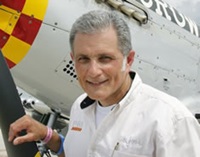

Warren Silberman
- Former Manager, FAA Aerospace Medical Certification
- Doctor of Osteopathic Medicine
- Expert in Aerospace/Preventive Medicine
- Pilot since 1986
The first thing he needs to do is let his physicians get him better and fit him with a prosthetic leg. He then needs to go out and find an instructor to fly with him and get used to using his new leg to fly. The physician who performed the surgery or another knowledgeable physician needs to type up an evaluation that describes how Silver is functioning with his new leg. It would be very helpful if this physician could comment that he feels that Silver has enough strength and flexibility in his leg to be able to manipulate the rudder pedals in his airplane. Alternatively, his aviation medical examiner could also type up such a letter to the FAA. Silver needs to bring the hospital records from the event (history, physical examination, discharge summary, operative report) and the current functional status letter to the AME or he can send the material directly to the Aerospace Medical Certification Division in Oklahoma City.
Silver is disqualified pending getting permission from the FAA to take a “medical flight test.” This is a flight check given by the airman's local flight standards district office (FSDO). Once the doctors at the FAA review the medical records and evaluations, they will send a letter to Silver that grants him permission to go to a FSDO close to him. (The airman has the option of requesting a particular FSDO that he or she is familiar with by attaching a letter requesting this to his or her packet.) Another letter from the FAA will be sent to the FSDO that introduces Silver to them and tells them his diagnosis, and enclosed in this letter are a medical certificate and a statement of demonstrated ability (SODA). A SODA is the name of a waiver issued by the FAA to an airman who has a static medical condition, meaning that the condition generally does not change over time. Silver then has six months to present himself to the FSDO to take the test.
The airman has to provide the airplane. The aviation safety inspector will then accompany him on a flight to make sure he is safe to fly with his prosthetic leg. When the flight is successfully completed, the inspector will present Silver with the medical certificate and SODA and type out a report that goes to the Medical Certification Division for inclusion in the airman’s record.
Should an airman have a condition that requires a modification to the aircraft, the pilot will need to have the aircraft modified to FAA specifications and learn to fly that particular aircraft. The flight test will be done in that aircraft. If the pilot passes the flight test, a limitation will be placed on the airman certificate that the pilot can fly that particular aircraft and if he wants to fly a more complex aircraft will have to have that one modified and take the exam in that aircraft and obtain another limitation.
So, Long John Silver can fly as a private pilot with a SODA.
To continue reading, please log in or join AOPA now to have access to these exclusive expert resources.
Let's say for the sake of a hypothesis that Mr. Long John Silver was not the infamous pirate with the West Country Bristolian accent of Treasure Island, but John Silver who lost his leg from the knee down as a result of a tangle with a great white shark when he fell overboard in his sailing vessel. He was lucky to survive, but he lost his lower leg.
Mr. Silver is an avid pilot and owns a Harvard T-6 warbird. He wants to continue to fly. What does he do?


